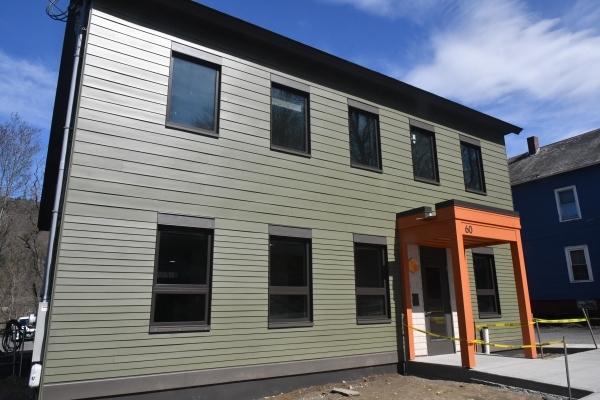BRATTLEBORO — When the Brattleboro Area Drop-In Center and Morningside Shelter merged in 2015 to become Groundworks Collaborative, the goal was to create an integrated network of services to provide food, shelter, medical care, and other assistance for those in need.
Seven years later, the vision has become reality.
The last piece of that effort is about to open on the site of the former Drop-In Center on 60 South Main St.
A new building, still a couple of weeks away from being fully furnished, will be home to Groundworks' Case Management and Representative Payee programs, as well as a dedicated location for its growing Healthworks collaboration.
“We're doing a lot of the things we did before here in the old Drop-In Center space, except now it's updated,” said Josh Davis, executive director of Groundworks. “It really is a coalescing of the vision we set out to do when we merged.”
Healthworks started in 2015 with a part-time clinician from the Brattleboro Retreat working on-site at Groundworks Shelter.
The program, with its dedicated and permanent home, will include a full-time Retreat clinical social worker, a registered nurse from Brattleboro Memorial Hospital, and a case manager with a focus on drug and alcohol counseling from Health Care and Rehabilitation Services (HCRS) - all of whom spend time working with participants at each of Groundworks' program locations.
Groundworks will also have more money to expand its embedded provider program at its supported housing sites at Great River Terrace on Putney Road and The Chalet in West Brattleboro. U.S. Sen. Patrick Leahy, D-Vt., garnered a $681,000 federal earmark to fund this work.
The Representative Payee Program provides clients with help managing their Social Security disability payments and their benefits. The program ensures that rent and basic living expenses are paid before spending money is disbursed to participants, keeping them on budget and in good financial standing to prevent any future threat of homelessness.
Building out the vision
The only vestiges of the former Drop-In Center are the hand-painted sign that used to be on the old building, and a three-sided brick fireplace and chimney - no longer functional - that was part of the original house, built in the late 1780s.
That 1,900-square-foot building, the long-time home of the Drop-In Center, was a busy and crowded place, and one of the first goals of Groundworks was to find more space for its services.
Its food shelf, located at the back of the original building, became a standalone operation on Canal Street in 2019. Now known as Foodworks, it is the most heavily used food-shelf program in southeast Vermont. Foodworks says that it has been distributing more than twice as much food as it did pre-pandemic.
The next piece was finding a permanent site for the winter overflow shelter, which moved from the former First Baptist Church to the Winston Prouty Center in 2017. With last fall's opening of a new Drop-In Center and temporary shelter on South Main Street, that goal was fulfilled.
All that was left was to find more space for Healthworks and the people who handled the paperwork and case management for Groundwork's clients.
Davis said renovating and preserving the original Drop-In Center was not possible because it was in such rough shape. Last fall, the old building was deconstructed and the new one was built by GPI Construction on the same footprint.
About 45 people now work within Groundworks' various programs, and the open office layout of the new space is designed for the way people work now, Davis said.
“Most are working some of the time from home, or out where the clients are,” he added. “This gives them a space to check in and file their paperwork and reports.”
Two rooms in the front of the building's first floor will be used as an exam room for the BMH staffers and for one-on-one therapy sessions. The rest of the first floor and the second floor will be used by the case management team.
Davis estimated the new shelter and offices that are sitting side-by-side on South Main Street cost about $4 million to build.
“It's just incredible to have them,” he said. “This is where the heart of our work is done.”
